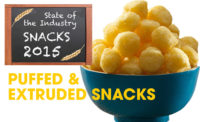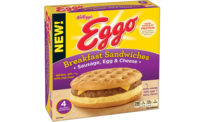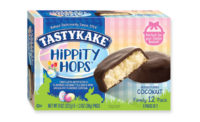In late 2012, the snack cake category experienced a major shakeup when Hostess Brands Inc.—renowned for its Twinkies, Ho Hos, Ding Dongs and other sweet baked goods—abruptly ceased operations in the wake of bankruptcy. Over the next few months, the company sold some of its bread and snack cake brands to Flowers Foods, Thomasville, GA, and McKee Foods, Collegedale, TN.
Overview | Bread | Tortillas | Sweet Goods | Snack Cakes | Pizza | Desserts | Cookies | Buns & Rolls | Bars
In early 2013, the company re-emerged as Hostess Brands LLC—with new private equity owners—reopened some of its remaining bakeries and began delivering Twinkies, CupCakes and Donettes to retailers by July, with other products following shortly thereafter.
But competitors didn’t sit by idly in the interim, and by 2014, the snack cake category was reinvigorated with new offerings and flavors—a pattern that continues today.
Market data
Despite growing consumer demand for healthier snacks, and the introduction of numerous better-for-you products in response, data from IRI, Chicago, reveals that the overall bakery snacks category recorded sales of $2.3 billion for the 52 weeks ending April 19, 2015—an increase of 5.32 percent from the previous year.
For the most part, the major players in the category saw sales climb, too. Hostess Brands saw dollar sales jump 47.11 percent for the 52-week period, which translated into $360.6 million, according to IRI. Twinkies racked up $103.5 million in sales, followed by Ding Dongs with $50.2 million, Zingers with $26.8 million and Ho Hos with $23.7 million.
And while McKee Foods saw its bakery snacks sales decline 4.17 percent for the year, the company still registered the most sales in the category for the given period—$630.7 million. However, its Little Debbie snack cake portfolio, which features Swiss Rolls, Cosmic Cupcakes, Devil Cremes and numerous other baked treats, experienced a 10 percent decline in sales—but still generated $320.6 million in sales for the period. This may be the result of internal competition with Drake’s Cakes, which McKee Foods acquired from Hostess in 2013 and offers similar snack cakes, including Ring Dings, Yodels and Devil Dogs.
Private label, the No. 2 sales leader in snack cakes, also continues to show sales gains, with dollar sales up 6.17 percent for the year, hitting $494.4 million. Safeway offers multiple snack cakes via its line dubbed The Snack Artist, as does Walmart in its Great Value line.
Mrs. Freshley’s, a Flowers Foods brand that offers Dreamies, Cupcakes, Snowballs, Swiss Rolls and other bakery snack products, had sales of $24 million (an increase of 5.16 percent) for the 52 weeks ending April 19. Flowers Foods’ Tastykake brand, meanwhile, saw sales decline 1.06 percent, to $87.4 million. Snack cakes, cupcakes, pies, doughnuts and numerous other products are available under the Tastykake name.
Sara Lee Snack Cakes, part of the Bimbo Bakeries USA family, Horsham, PA, saw a healthy sales increase of 15 percent—to $42 million—for the 52 weeks ending April 19, according to IRI. The maker of fudge cakes, cupcakes, honey buns and more launched individually wrapped Devil’s Food Crème Cakes and Buttery Sunshine Cakes in fall 2013, and, reportedly plans to expand its offerings in the coming months.
Looking back
So what’s helped snack cakes—considered by many to be the antithesis of better-for-you snacks—hold their own during a time when consumers allegedly are seeking healthier treats?
“While there is interest in products with healthier profiles—and the demand for those items has increased—the sweet baked goods category continues to be largely driven by indulgence,” says Brent Bradshaw, vice president of marketing/cake, Flowers Foods. “Consumers also want snacks that deliver on taste and quality. Tastykake and Mrs. Freshley’s are working to develop products that meet both consumer trends.”
When it comes to taste, snack cake manufacturers have been staying on top of many of the flavor trends that have been appearing across other snack categories.
“Consumers—especially younger consumers—are interested in new and innovative taste experiences,” says Bradshaw. “That’s why innovation is a top priority for all of our snack cake brands, including Tastykake and Mrs. Freshley’s. We partner with other well-known brands, including Cinnabon, to deliver the new snack cake experiences consumers want. We are also offering a seasonal line of limited-edition items, such as Salted Caramel and Strawberry Mini Donuts, to keep the offering fresh.”
Other recent introductions include limited-edition TastyKake Kandy Kakes in Lemon, Cherry and Strawberry; Tastykake Red Velvet Mini Donuts; Mrs. Freshley’s Cinnamon Twirls; and Mrs. Freshley’s Strawberry Shortcake Cupcakes.
Hostess, meanwhile, introduced limited-edition Red Velvet Cupcakes in February and Sea Salt Caramel Zingers and Cupcakes in May. The former will reportedly return to the company’s lineup full-time this fall, as will the popular Suzy Q’s.
Dawn Food Products Inc., Jackson, MI, maker of Weight Watchers Sweet Baked Goods, tapped into the popularity of these flavors—along with demand for better-for-you treats that are still indulgent—to add Weight Watchers Red Velvet Crème Cakes and Weight Watchers Salted Caramel Brownie Bliss to its offerings. Other Crème Cake flavors include Chocolate, Carrot and Lemon. Brownie Bliss is also available in Mint Chocolate, Triple Chocolate and Peanut Butter. Despite this new product activity, IRI data reveals that sales of Dawn Food’s Weight Watchers Bakery Snacks dropped 22.16 percent for the 52 weeks ending April 19, to $23.4 million.
Leslie Kaplan, co-founder of The Piping Gourmets, Miami, says her company also looked at top flavors on the market when developing its Whoopie Pies, which can be found in grocers’ freezer section. The line currently comprises Chocolate Vanilla, Vanilla Vanilla, Chocolate Mint, Chocolate Raspberry, Vanilla Lemon and Chocolate Chocolate.
Besides on-trend flavors, Whoopie Pies offer health-conscious consumers—as well as those with dietary restrictions—an indulgent treat because they’re certified gluten-free and vegan, Non-GMO Project verified, dairy-free, kosher and pareve. “That collection together makes us a unique dessert,” says Kaplan.
The Piping Gourmets’ Whoopie Pies also come in individually wrapped, single-serve portions, another attribute important to consumers—with each individually wrapped snack cake comprising one portion. “Sometimes, what we’ve seen in the snack industry is that other brands will put something in a single-serve package, but if you read the fine print on the back, it says two and a half servings,” says Kaplan.
Convenient, single-serve packaging will continue to draw-in consumers looking for a sweet, portable treat, notes Bradshaw. “Portability is a large differentiator in the snack cake category, whether it’s an afternoon snack at the office or in a packed lunch, snack cake’s individually wrapped portions meet the needs of families who are on the go,” he says.
Consumers’ request for convenience and single-serve snacking helped the Snack’N Loaves foodservice snack-sized cakes from J.S.B. Industries, Chelsea, MA, take off over the past few years, says Scott Anderson, vice president of the company. Flavors include Blueberry, Coffee Cake and Cornbread. “Healthy grab-and-go snacks that you don’t feel guilty about eating are exactly what today’s on-the-go consumer is looking for,” he adds.
Lance Aasness, executive vice president, Hinds-Bock Corp., Bothell, WA, sees a current focus on portion-control items, such as mini cakes, muffins and other sweet goods. And sometimes, the smaller, the better. “Bite-size products are very convenient, and with their popularity, more companies are producing them,” he says.
Aasness says his company’s Mini-Product Lines are ideal for batter inclusions in mini muffins and cakes. “The machines can handle smaller particulates like blueberries and nut pieces without crushing them,” he explains. “They reduce costs with accurate filling and portion control. They improve payback with versatility, ease of maintenance and operation, easy sanitizing and rapid flavor changeover.”
Improved plant efficiency can also help snack cake manufacturers develop a competitive edge. “Ribbon blenders are traditionally the most-popular machines we supply for making cakes and baked goods in general,” says Christine Banaszek, application engineer, Charles Ross & Son Co., Hauppauge, NY. “More recently, however, we’ve also built a number of double planetary mixers, discharge systems and high-shear mixers for producing icings, frostings and gum dispersions. We believe the reasoning behind the shift in technology from conventional kitchen mixers and food processors to these types of specialty mixing equipment is improved efficiency, as well as the capacity to produce larger-scale batches in-house and on-demand.” She notes that customers look for machines that will offer them shorter cycle times, more-convenient material handling—like charging and discharging—and easy cleaning.
Looking ahead
On-trend flavors, single-serve portions, convenience and, perhaps most of all, consumers’ inherent desire for an occasional indulgent treat continue to drive sales of snack cakes and other sweet baked goods—even though so many people say they’re trying to be more mindful of what they eat.
Prevailing trends often have associated countertrends, and perhaps snack cakes—a smaller-portioned, occasional, affordable indulgence—will remain as a moderating influence on the wave of better-for-you crashing across multiple other bakery categories. But that doesn’t mean we won’t see slight nutritional improvements in select product lines in the coming year or so.
“People aren’t going to give up their desserts,” says Kaplan, “but they know that they do need to be responsible and not eat a whole cake or pie.”
The clean-label “health halo” is another factor manufacturers need to consider moving forward in order to appeal to certain segments of shoppers. “Everyone needs to look at their ingredient profile,” says Kaplan. “They really need to clean up that list. We did it, and we’re a small company. If we did it, we believe everyone else can, too. And slowly, but surely, they are. The trick is to still maintain quality, taste and texture, and make sure the product is delicious. The major companies just need to take a look at and revise the ingredients they’re using—and their serving size.”
For a category like snack cakes, this process will require judicious balancing during new product development. “The snack cake category will continue to move in a more healthy or good-for-you direction, while continuing to satisfy the consumer’s indulgent desire for a sweet and delicious snack,” says Anderson.
And while snack cake classics will likely long find an audience connected via nostalgia—along with younger consumers experiencing these indulgent sensations for the first time—manufacturers of snack cakes will continue to look toward flavor-forward profiles to cultivate wider spheres of influence. “We are confident the outlook of this category will remain strong, as consumers continue to enjoy great-tasting sweet snacks and demand new taste experiences,” says Bradshaw.
Overview | Bread | Tortillas | Sweet Goods | Snack Cakes | Pizza | Desserts | Cookies | Buns & Rolls | Bars














